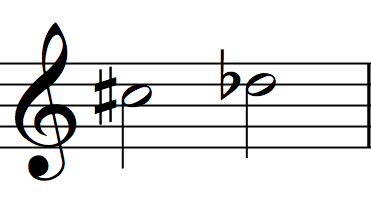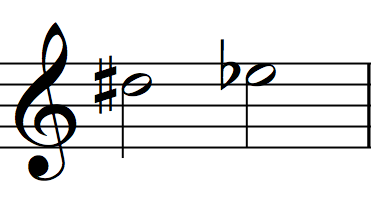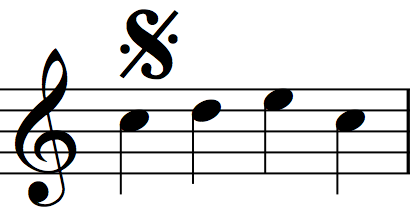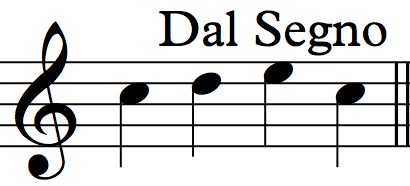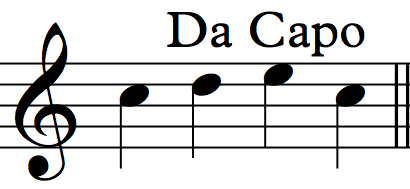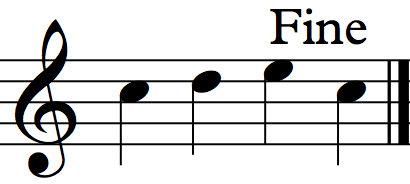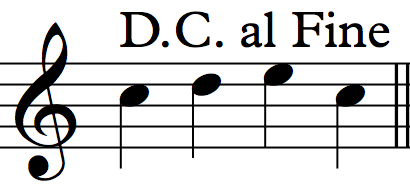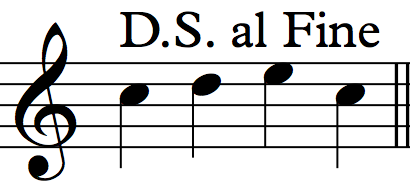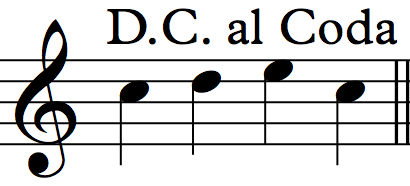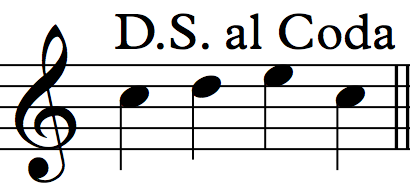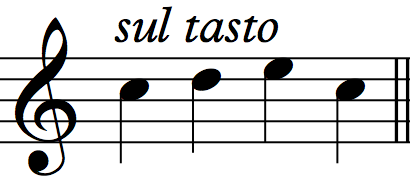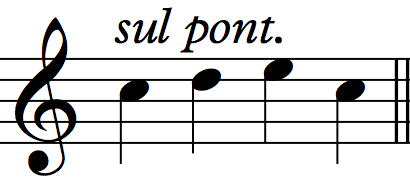11 More Notes, Color & Navigation
INTRODUCTION
In this unit you will learn more fretted notes on the second string, more navigation symbols and tone colors.
NOTATIONS
Notes
The Notes ‘C♯’ & ‘D♭’
‘C♯’ and ‘D♭’ are enharmonics. To play ‘C♯’ and ‘D♭’, fret the second fret on the second string.
The Notes ‘D♯’ & ‘E♭’
‘D♯’ and ‘E♭’ are enharmonics. To play ‘D♯’ and ‘E♭’, fret the fourth fret on the second string.
The Note ‘E’
You already learned to read this note as the open first string. However, this same pitch can be played as the fifth fret of the second string as well.
Navigation Symbols
The following symbols and Italian phrases direct you to repeat sections of music, often by jumping backward and forward in the score. Centuries ago, when paper was far more expensive than it is now, these symbols were cost effective. These symbols are still used today because musicians prefer to play from scores with minimal pages.
Coda
The Coda looks like an ellipse covered by a cross. It means “tail” in Italian. The Coda marks the starting point of the composition’s last section.
Segno
The Segno looks like an upper case “S” bisected by a diagonal line and dots. It means “sign” in Italian. Placed within the piece (not the beginning or ending), it marks a section to be repeated at a later point in the piece’s progression.
Dal Segno or D.S.
D.S. is the abbreviation of Dal Segno. It means “to the sign” in Italian. The phrase directs you to go back to the Segno symbol.
Da Capo or D.C.
D.C. is the abbreviation of Da Capo. It means “to the head” in Italian. The phrase directs you to go back to the beginning of the piece.
Fine
The Fine is written directly into the score. It means “the end” in Italian. It marks the end of the piece. Navigation symbols allow you to jump around a score. Occasionally, a piece will end somewhere in the middle of the score.
Combinations of Navigation Symbols
D.C. al Fine
The D.C. al Fine directs you to go back to the beginning of the piece and play until the Fine.
D.S. al Fine
The D.S. al Fine directs you to jump to the Segno and play until the Fine.
D.C. al Coda
The D.C. al Coda directs you to jump to the beginning, play to the Coda, jump forward to the other Coda, and play to the end of the piece. Traditionally, two Coda symbols were placed in the score. However, in standard practice today the Coda symbol is often replaced by the actual words ‘To Coda’ and ‘Coda.‘
D.S. al Coda
The D.S. al Coda directs you to jump to the Segno, play to the Coda, jump forward to the other Coda, and play to the end of the piece. In this case, two Coda symbols (or words) will be placed in the score.
Tone Color
Three tone colors are commonly used in guitar notation. The following directions can appear in regular font, italicized font or as an abbreviation. See the video above for an example of bright, warm and ordinary tone colors.
Sul Tasto or ‘ST’
This phrase, which means ‘at the neck’ in Italian, directs you to either pluck near the neck (for acoustic guitar) or engage the neck pick-up (for electric guitar) to produce a warm color.
Sul Ponticello or ‘SP’
This phrase, which means ‘at the bridge’ in Italian, directs you to either pluck near the bridge (for acoustic guitar) or engage the bridge pick-up (for electric guitar) to produce a bright color.
Ord. or Norm. or Nat.
The words ordinary, normal and natural often appear as abbreviations, which direct you to cancel the non-standard technique that preceded it in the score. In the case of guitar, the ordinary way of playing involves plucking over the sound hole (for acoustic guitar) or engaging both pick-ups (for electric guitar) to produce a full and even tone.
Let’s Play |
Sight-Reading Tip
Many pieces contain repeated musical material. When you scan the piece prior to sight-reading, practice jumping your eyes from one section to another, according to the directions of the navigation symbols. Great sight-readers train their eyes to scan and jump around the score with rhythmic precision. Sight-reading forces us to react to information quickly and trust our instincts.
Checklist for Sight-Reading
- Count the beats out loud (including the &).
- Keep going (even if you make a mistake).
- Maintain your best playing posture.
- Look at the score, not your hands.
- Play with the feel of the meter.
- Play patterns instead of individual notes (AKA chunk).
- Cultivate a calm demeanor.
- Have fun!
Let’s Play Rhythms |
Attitude Tip
Nearly all the best things that came to me in life have been unexpected. –Carl Sandburg
Exercise 11.1: Score
Exercise 11.1: Audio
Exercise 11.2: Score
Exercise 11.2: Audio
Exercise 11.3: Score
Exercise 11.3: Audio
Exercise 11.4: Score
Exercise 11.4: Audio
Let’s Play Patterns |
Attitude Tip
I’m not afraid to look like an idiot. –Anthony Bourdain
Exercise 11.5: Score
Exercise 11.5: Audio
Exercise 11.6: Score
Exercise 11.6: Audio
Let’s Play Duets |
Attitude Tip
Just continue in your calm, ordinary practice and your character will be built up. –Shunryu Suzuki
from Courante à L’italéne by François Couperin: Score
from Courante à L’italéne: Audio
The next piece contains many repeated sections and a D.C. al Fine. When you reach the D.C. al Fine and go back to the top of the piece, play the music within the repeat bars only once. This is standard practice.
Muzette by François Couperin: Score
Muzette: Audio
Let’s Play Compositions |
This composition is under the Creative Commons Attribution-NonCommercial 4.0 International License (CC BY-NC 4.0).
Attitude Tip
The supple willow survives the tough pine in a snowstorm, for whereas the unyielding branches of the pine accumulate snow until they crack, the springy boughs of the willow bend under its weight, drop the snow, and jump back again. –Alan W. Watts
Around by Joan Greenwald: Score
Around: Audio
Congratulations!
You have completed this unit! If you kept up with the beat and accurately played approximately 70% of the pitches and rhythms, you are ready for the next unit. Feel free to repeat the exercises. However, do not play them so often that you memorize them. Once you memorize the notation, you are no longer developing the skill of sight-reading.

